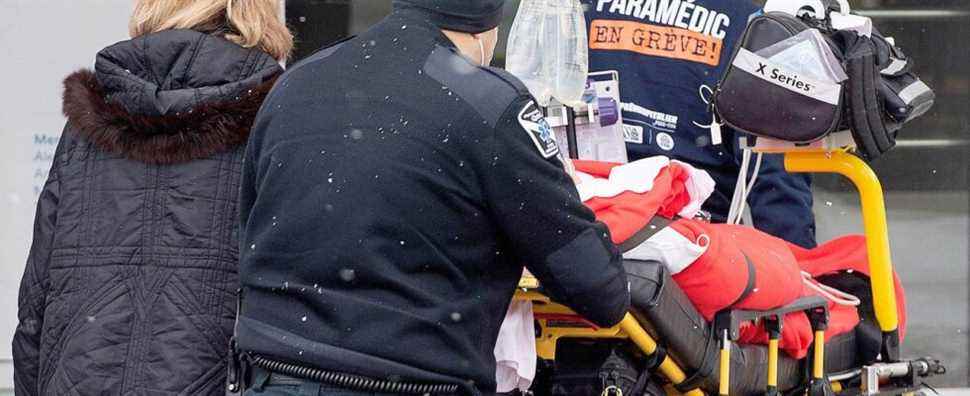Faced with the magnitude of the wave raised by the Omicron variant, the hospitals set out again to war and the personnel prepared the trenches. Hot zones and COVID units are multiplying inside hospitals, symbols of a network that apprehends the danger to come.
Santa Cabrini Hospital in Montreal had never needed a COVID wing. This was before Omicron swept across Quebec, bringing with it, over the past five days, 48,000 cases and nearly 500 hospitalizations.
Santa Cabrini will provide reinforcements that have become necessary to the Maisonneuve-Rosemont hospital, which was treating 28 patients in its 32-bed COVID unit on Tuesday.
At Cité-de-la-Santé in Laval, the “3 Ouest-Nord” already accommodates 24 patients out of a maximum capacity of 25. Each day brings this unit closer to saturation. A second is necessary: it should open soon and bring the number of beds reserved for COVID patients to 33.
Already, the CISSS de Laval has a plan C in its boxes. In the event of an overflow in the second COVID unit, patients whose condition allows it could be sent to a floor of the Vieux-Moulin Installations, a former RPA rented by the Laval Integrated Health Center. Fifteen additional COVID patients could stay there, specifies Judith Goudreau, spokesperson for the CISSS.
In Quebec City, CHU hospitals and the University Institute of Cardiology and Pulmonology have “accordion” COVID units. “When the cases of COVID climb, we adjust to the demand,” says Caroline Laprise, director of communications at the Institute. “Sections are added as the needs grow. “
The more patients COVID brings to these facilities, the more the COVID frontier grows. “The hot zones get bigger: we then block a floor or a corridor, we restrict access behind the doors and we prepare negative pressure rooms inside the perimeter”, explains Jean-Thomas Grantham, assistant to the p .-dg of the CHU de Québec. “It’s a hospital inside the hospital. “
Variable geometry
The construction and dismantling of these sanitary ramparts follow the evolution of the pandemic. The hospitalization curve goes down, the barriers are falling. She goes up, the barricades too.
A new beginning that recalls the punishment of Sisyphus: the nursing staff carry the burden of the pandemic to the peak of each wave that breaks, with, at the slightest variation, a peak higher than the previous one to overcome. And with fewer and fewer colleagues to help them.
In Chaudière-Appalaches, Tuesday, 327 workers infected, isolated or waiting for a result were missing in the network. “The more things go, the more difficult it becomes in terms of the workforce,” concedes Marco Bélanger, deputy director general at the CISSS de Chaudière-Appalaches.
By early fall, the region’s largest hospital had dedicated a full floor to COVID-19 patients. In the elevators of the Hôtel-Dieu de Lévis, few were the visitors to go up to the fifth, designated hot zone. A worker who entered in the morning did not leave until the end of his shift.
Since then, the directives of the Ministry of Health intended for hospitals allow isolation in single rooms. “A zone reserved for the patient is defined as being at least a closed room or a radius of two meters around the user”, writes the ministry in an instruction sent on August 6. This is the approach favored by the CISSS de Chaudière-Appalaches, an approach that avoids assigning a large number of workers to a single sector.
At the Hôtel-Dieu de Lévis, the comings and goings are now constant on the fifth floor, where the red zone, now dismantled, has given way to day medicine services. Patients with COVID are now grouped together in care units. Staff move from room to room wearing and changing their personal protective equipment, explains Marco Bélanger of the CISSS. A nurse can thus treat a patient with COVID, then change his gown, gloves and mask and, the next moment, look at a patient spared by the coronavirus.
They are preparing for war
The pandemic has already caught up with the hospital capacity of the region: Tuesday morning, the CISSS planned to transfer “between six and eight patients” to establishments in Quebec, where the health situation still allows staff to lend a hand to neighboring territories. “In all, there are 35 hospitalizations in our four hospitals, of which 7 are in intensive care,” says Mr. Bélanger. We have exceeded the capacity of phase 2, set at 33 COVID beds. We are going to start implementing phase 3, which will allow us to open 10 additional beds. “
In Sherbrooke, the two hospitals formerly designated COVID preferred to keep their hot zone, despite the dismantling authorization granted by the Ministry of Health published in August. The COVID unit looks like a front line: temporary physical walls, airlocks inside which workers put on and take off their protective equipment, sealed doors and special ventilation. “They are preparing for war”, illustrates the Dr Bernard Gélinas, who visited the facilities in previous waves.
The rapid community transmission will force Public Health to reduce its services to dedicate more beds to COVID patients. Already, the capacity of level 2 is exceeded. A level 3 load shedding must be set in motion soon to make 66 COVID hospital beds available, in addition to 18 intensive care beds, explains the CIUSSS de l’Estrie.
“The Delta was expected, concludes the Dr Gelinas. The Omicron was a little less so. “
